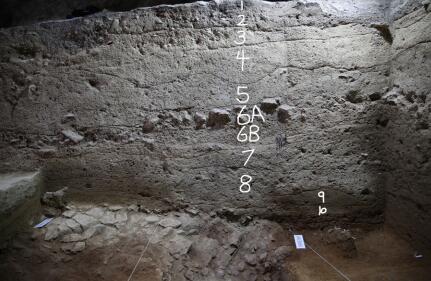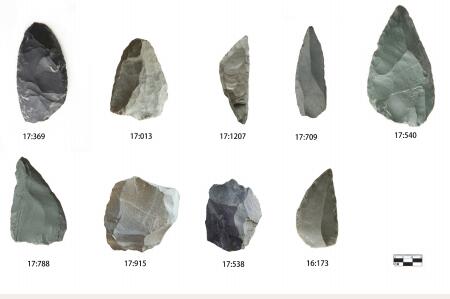Middle Paleolithic remains found in Tongtiandong Cave Site in Xinjiang
From:Chinese Archaeology NetWriter:Date:2018-01-18
The excavation of Tongtiandong Cave Site has been done from 2016 to 2017 in Jeminay County. The Xinjiang Uyghur Autonomous Regional Institute of Cultural Relics and Archaeology together with School of Archaeology and Museology of Peking University cooperated in the project. The excavation area reached 65 square meters. The interim cultural deposition between the middle and upper Paleolithic Age dating back to 45,000 years ago was uncovered, contained the unearthed stone-tools, bronze ware and iron ware together with specimens and fossils add up to 2000 pieces. According to the excavation, Tongtiandong Cave Site is the first Paleolithic cave site ever found in Xinjiang. Meanwhile, it also provided the continuous stratigraphic cultural-layer sections of Paleolithic - Chalcolithic - Bronze Age - Early Iron Age. Tongtiandong Cave Site is a granite cave remaining in Jeminay County, Altay Prefecture, Xinjiang Uyghur Autonomous Region. The altitude is 1810 meters.
Distant view of Tongtiandong Cave Site
At the beginning of 2016, the archaeological team made trial excavation inside and outside the cave to probe the scale and nature of the cave and explore to understand the archaeological culture consequence and related remains. The nature and time of the stone-tools were preliminarily identified through trial excavation. Many pottery fragments, millstones and fire use evidence were found in Unit T0505 outside the cave. There were also remains of stone piles.
The archaeological team made a second excavation to Tongtiandong Cave from June to September 2017. Samples’ Information concerning the type, three-dimensional coordinates, strata deposition, horizontal section and attitude as well as weathering erosion were recorded elaborately, and extraction of dating samples, floating soil samples, soil micromorphology samples and DNA soil samples was also carried out.

The aerial photo of Tongtiandong Cave Site
Achievement and Significance
For the past two years’ excavation, it reflected that the deposition in Tongtiandong Cave was thick and the most in-depth spot was 3 meters below the surface. The excavated area contained 14 stratums, which were classified into four groups.
Pottery, bronze ware, iron ware and millstones were found in the stratum of the early Iron Age and the Bronze Age, mainly belonging to Afanasievo Culture and Karasuk Culture. Remains of the stone walls surrounding the cave were also found in Unit T0505 and there was also an ash pit with the diameter of 1.2 meters outside the stone wall. Carbonized wheat (Triticum aestivum L.) was gained with flotation method in the early Iron Age and Bronze Age deposition in Unit T0505. The C14 dating of the wheat sample was 5000 to 3500 years ago (verified). It showed that Tongtiandong Cave might be one of the earliest Chalcolithic sites in Xinjiang. It was used repetitively from the Bronze Age to the Early Iron Age.

The section showed bronze age layers
Around 2000 pieces numbered samples were unearthed from the Paleolithic stratums, among which one third were stone-tools and another one-third were animal skeleton fossils. In addition, around 10 thousand tiny animal fossils and stone-tool samples were also filtered. Most were animal fossils, especially small animal fossils. There were varied types of stone-tools, including typical Levallois technique lithic core, discoid core, Levallois Points, scrapers and Mousterian Points. Overall, it displayed apparent Middle Paleolithic cultural characteristics in the west of the Old World. Compared with other sites of the same time in China, it was unique. It also filled the blank of typical Middle Paleolithic Mousterian culture in China. The animal skeletons were highly fragmented with obvious traces of cutting, burning and knocking. The identifiable species included carnivores, rabbits, sheep, donkeys, rhinos, bears and birds and other skeletons of small animals, offering precious data for studying the human utilizing of animal resources and environmental changes of the site.

The millstone,found in unit T0505.
Three ash pits were unearthed in situ in the Paleolithic cultural stratum. They were in regular circles with clear boundary and the diameters were 50 to 70 centimeters. The numerous ash deposition and stone-tools together with animal skeleton fossils embodied that Tongtiandong Cave Site used to be the residence of ancient people. According to the C14 dating of animal fossils, the Paleolithic cultural deposition was dated to 45 thousand years ago.

Stone Tool Assemblage
Tongtiandong Cave was the first Paleolithic Age cave site found in Xinjiang Uyghur Autonomous Region. It also provided the continuous stratigraphic cultural-layer sections of the Paleolithic, the Chalcolithic, the Bronze Age and the Early Iron Age for the first time in this region. The deposition was in clear consequence, covering a huge time span. It not only filled the blank of pre-history cave-site archaeological research in Xinjiang, but also was a significant Paleolithic Age archaeological discovery in China. Tongtiandong Cave Site provided great significance to the understanding of evolution and development of ancient people in Xinjiang region for over 40 thousand years as well as establishing of regional cultural development chronological framework.
Tongtiandong Cave Site was probably one of the earliest Chalcolithic site in Xinjiang, which also occurred repetitively in the Bronze Age and the Iron Age. The earliest wheat was found, but the specific information shall be proved by further detailed archaeological excavation. Even so, we can at least speculate that wheat appeared early in this region, and there likely to be a way of wheat spread trading. (Translator: Yuan Yuan Photo: Archaeology Press IA CASS)

